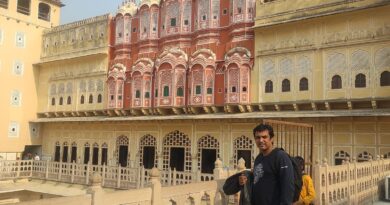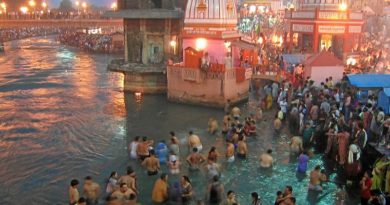The Nectar of Life at Haridwar
January 2010 and the pulse of Haridwar, the holy city at the foot of the mighty snow-capped Himalayas, started to quicken as it prepared to host the Kumbh Mela after a gap of 12 years. On the 14th of January, the city erupted in a shower of pious euphoria as a procession of ash covered sadhus with flowing beards and knotted manes led a crowd of milling pilgrims into the holy Ganga for a ritual cleansing dip. The Kumbh Mela of 2010 had commenced with much zeal and characteristic chaotic frenzy.
Over the next three months, there will be a series of 10 ritualistic snans or bathing days that coincide with auspicious days of celestial significance. The festival reaches a crescendo with the Royal Baths on 12 February and 15 March 1998 after which it tapers off; the last ‘bath’ taking place on 28 April. It will be another 12 years before the Maha Kumbh returns to Haridwar again.
The Maha Kumbh dates back to the creation of the universe. According to Hindu mythology, the devas and the ashuras once decided to set aside their eternal differences and together retrieve the Kumbh (pot) that contained the nectar of immortality from the depths of the ocean. Using a giant serpent as a rope the two groups started to churn the ocean. Almost immediately the waters started to release its many treasures as well as other evil elements. Just before it was ready to finally surrender the nectar of immortality, a cloud of vish or poison escaped and threatened to contaminate the entire universe. At that crucial moment Lord Shiva stepped in and swallowed the vish in one large gulp. But rather than consume it, he held the deadly poison in his throat and as a result his body turned to a deep shade of blue.
When Dhanwantari, the divine healer, finally appeared with the Kumbh in his hands, a great fight broke between the two sides, each one trying to wrest the pitcher for themselves. During the fierce battle that raged across the sky, a few drops of the immortal elixir fell at four different places in India: Prayag (Allahabad), Nasik, Ujjain and Haridwar. Ever since, when the configuration of the stars and planets are just right – when Jupiter enters Aquarius and the Sun is in Aries – the waters of the rivers that run through these cities once again turns into nectar. It is believed that a dip in these miraculous waters at this point of time heals and cleanses the soul and body. This event, known as the Kumbh Mela, happens once every three years and in rotation between the four cities. This time around it is the turn of Haridwar to play host to what is probably one of Hinduism’s most important and colourful festivals. Considered as one of the seven most sacred cities in India, the city which sits on banks of the Ganga at the point when it leaves the Himalayas and enters the great northern plains, is dotted with innumerable temples, ashrams and yoga centers. Down the ages it has been an important centre of learning and even today it is a torchbearers of traditional and cultural sciences like herbal medicine, yoga and meditation.
But it is during the Kumbh Mela that the city is in the eye of a staggering happening. Anywhere between 10 to 12 million pilgrims (the largest gathering of human beings on earth at any given time) are expected to participate in this years’ event. The chiming of temple bells, the fragrance of flowers and incense sticks and the chanting of Vedic hymns and mantras swirl through the vast crowds, adding a fevered pitch of devotion to the experience.
And when the Kumbh is over and a semblance of sanity returns once more to Haridwar, one may sit by the riverside in the evenings and watch the spectacular sight of thousands of diyas or lamps with flickering flames dance across the water as part of the Ganga Arti. It is a reassurance that the immortal Ganga will flow on and all is well with the world.
Bathing Dates The main bathing dates of the 2010 Kumbh Mela at Haridwar are as follows: 14 Jan 2010 Makar Sankranti Snan – First Snan (bath) 15 Jan 2010 Mauni Amavasya and Surya Grahan (Solar Eclipse) – 2nd Snan 20 Jan 2010 Basant Panchmi Snan – Third snan 30 Jan 2010 Magh Purnima Snan – Fourth Snan 12 Feb 2010 Maha Shivratri – Pratham Shahi Snan – First Royal Bath 15 Mar 2010 Somvati Amavasya – Dvitya Shahi snan – 2nd Royal Bath 24 Mar 2010 Ram Navmi – Fifth Snan 30 Mar 2010 Chaitra purnima snan 14 Apr 2010 Baisakhi – Pramukh Shahi Sanan 28 Apr 2010 Shakh Purnima – snan Fact File Haridwar is 214 km by road from Delhi, which is the nearest airport that receives regular scheduled flights.
The city’s station is an important railhead on the line between Delhi and Dehradun and is connected by direct trains to Delhi, Bombay, Calcutta, Varanasi and Allahabad.
By road, Haridwar is 24 km from Rishikesh, 52 km from Dehradun, and 90 km from Mussoorie. The city has a wide range of accommodation to suite all budgets, including Leisure Hotels’ luxury tented resort that sits on the banks of the river.

